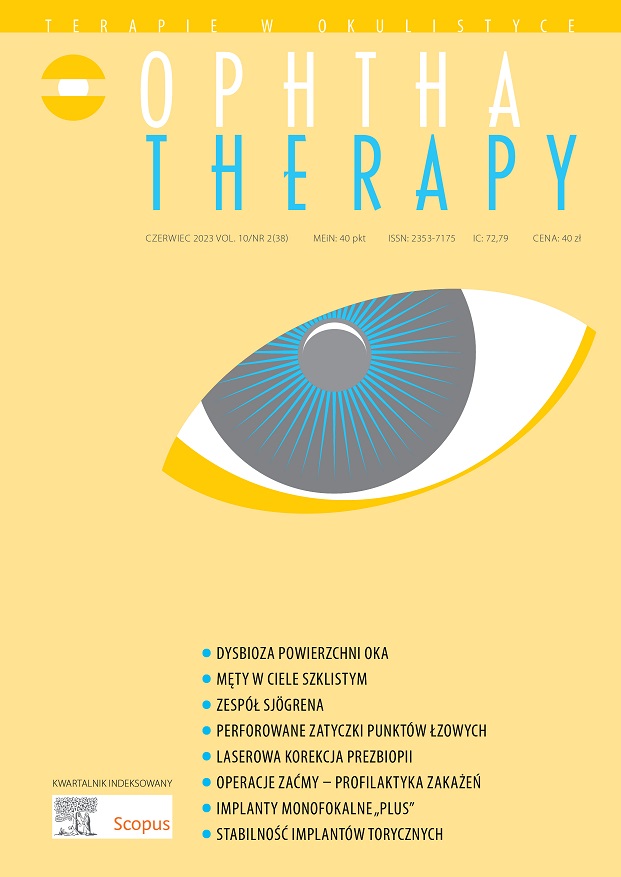Rotational stability of the enVista® toric lens compared to other commonly implanted toric intraocular lenses – a literature review Review article
Main Article Content
Abstract
Preoperative corneal astigmatism higher than 1 D is present in up to 30–47% of eyes with cataracts. Proper correction of astigmatism, apart from the adequately determined spherical power of the artificial intraocular lens (IOL), is the main factor ensuring the desired result of the procedure manifested as postoperative spectacle’s independence, visual function, and as a result – patient satisfaction. Toric IOL implantation allows simultaneous cataract removal and correction of corneal astigmatism during one surgical procedure. Since the introduction of toric IOLs, more rotationally stable lenses allowing for better refractive performance have been introduced to clinical practice. EnVista® is an acrylic toric IOL (enVista® MX60T; Bausch and Lomb Inc., Rochester, NY, USA), which was introduced in 2018, and currently is one of the most used toric IOLs in clinical practice worldwide. Rotational stability, apart from adequately selected spherical and toric IOL equivalents, is the most crucial parameter determining the benefits of using a toric lens because it is estimated that for every 1° of rotation of the toric IOL from the target axis, the correction of astigmatism is reduced by 3.5%; therefore a significant change of position in the postoperative period may require another surgical intervention. In this review, based on published research, we summarized the rotational stability of the enVista® lens compared to the other toric IOLs available on the market.
Downloads
Article Details
Copyright: © Medical Education sp. z o.o. License allowing third parties to copy and redistribute the material in any medium or format and to remix, transform, and build upon the material, provided the original work is properly cited and states its license.
Address reprint requests to: Medical Education, Marcin Kuźma (marcin.kuzma@mededu.pl)
References
2. Emesz M, Dexl AK, Krall EM et al. A randomized controlled clinical trial to evaluate different intraocular lenses for the surgical compensation of low to moderate-to-high regular corneal astigmatism during cataract surgery. J Cataract Refract Surg. 2015; 41(12): 2683-94.
3. Mallias I, Mylova P, Tassiopoulou A. Correction of astigmatism with toric intraocular lenses. Ophthalmol J. 2017; 2: 49-53.
4. Singh A, Kapoor G, Baranwal VK et al. Rotational stability of Toric intraocular lenses. Med J Armed Forces India. 2022; 78(1): 68-73.
5. Kramer BA, Hardten DR, Berdahl JP. Rotation characteristics of three toric monofocal intraocular lenses. Clin Ophthalmol. 2020; 14: 4379-84.
6. Torio KC, Ang RET, Martinez GHA et al. Comparison of the Rotational Stability of Different Toric Intraocular Lens Implants. Philipp J Ophthalmol. 2014; 39(2): 67-72.
7. Packer M, Fry L, Lavery KT et al. Safety and effectiveness of a glistening-free single-piece hydrophobic acrylic intraocular lens (enVista). Clin Ophthalmol. 2013; 7: 1905-12.
8. Schartmüller D, Schwarzenbacher L, Meyer EL et al. Comparison of long-term rotational stability of three commonly implanted intraocular lenses. Am J Ophthalmol. 2020; 220: 72-81.
9. Shah GD, Praveen MR, Vasavada AR et al. Rotational stability of a toric intraocular lens: influence of axial length and alignment in the capsular bag. J Cataract Refract Surg. 2012; 38(1): 54-59.
10. Vokrojová M, Havlíčková L, Brožková M et al. Effect of Capsular Tension Ring Implantation on Postoperative Rotational Stability of a Toric Intraocular Lens. J Refract Surg. 2020; 36(3): 186-92.
11. Guzmán-Iturbe FD, Chávez-Mondragón E, de la Cruz DZ et al. Rotational stability and visual outcomes with the implantation of the enVista MX60T TORIC intraocular lens. Rev Mex Oftalmol. 2019; 92(3):129-35.
12. Buckhurst PJ, Lau G, Williams JI et al. Efficacy of a One-Piece Aberration Neutral Hydrophobic Acrylic Toric Intraocular Lens. Clin Ophthalmol. 2022; 16: 3763-74.
13. Garzón N, Poyales F, de Zárate BO et al. Evaluation of rotation and visual outcomes after implantation of monofocal and multifocal toric intraocular lenses. J Refract Surg. 2015; 31(2): 90-7.

